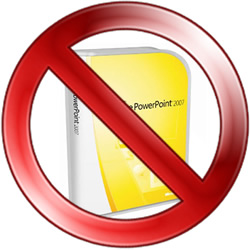Strategy
Selling Without Slides
 It's a scenario played out in millions of sales meetings every year.
It's a scenario played out in millions of sales meetings every year.
The eager consultant (or lawyer, accountant or salesperson) has finally managed to get a meeting with one of his A list target customers. The customer meets him at reception, takes him to a meeting room and opens with “tell me a little about your company”.
“I'm glad you asked” says our hero as he brings out his pack of slides (or perhaps a glossy brochure, or even worse, his computer) and proceeds to give a thoroughly professional presentation – which unfortunately, does nothing to further the client relationship.
After a brief discussion afterwards the client offers to “call you when we need something in your area”, and the two never speak again.
Of course, it's hardly news that initial meetings with clients need to be about establishing relationships and trying to identify the client's critical needs. The problem is that far too many of us rely on the use of slides or a pre-prepared presentation as a crutch – without realising that the presence of the visual aid can often be a barrier to establishing the relationship we're looking for.
The first problem is that the potential client is no longer having a face-to-face dialogue with you – they're looking at your slides or brochure – or worse still, they're looking at a screen and you're not even physically close to them.
Secondly, if you present material, the meeting changes from dialogue to presentation. From a peer-level discussion to a “master-servant”, “I'm trying to impress you” dynamic.
Finally, the most likely outcome of a presentation is that they begin to ask questions about the presentation. That's what happens when we listen to presentations – they trigger questions and we ask them.
But, of course, at this point it's really you who needs to be questioning them. Trying to find out what they're looking for, what their challenges and problems are.
A far more effective approach is to be able to briefly describe your company in a few sentences, then turn to asking the client about their company, their challenges and what they are hoping to achieve. You can establish your and your company's credibility far more with intelligent questioning and a few “that's interesting, we worked with a client who had what looked like a similar issue recently, they…” follow-ups.
If you need to illustrate points, try a “pencil selling” approach. Have a few blank sheets of paper situated between you and the client and sketch out what you want to show them. It's far more effective and demonstrates your knowledge of the subject rather than just your ability to show slides which could have been prepared by someone else.
Better yet, you can hand the pencil to the client and get them to share in the process – adding in their thoughts and taking co-ownership of the solution or plan you are creating together.
And without the distraction of slides, brochures, or even worse, a computer to look at; you can begin to establish real human to human rapport. This may be the most crucial aspect of all as a potential client is highly unlikely to begin to open up and tell you about any significant problems they have until you establish a base level of trust and credibility with them. And that's so hard to do when you are presenting preprepared material.
So why do we rely on slides and brochures so much?
Very often it's because we have neither the confidence, nor have we done the homework needed to allow us to work without our visual aids. We can't remember all the key points we want to get across, the major benefits to the customer, and our great testimonials. We put all our preparation time into creating the presentation – rather than in thinking about how we should present it.
Ironically, we need to know our presentation and our slides absolutely off-pat – so that we can then do without them and begin to build a real dialogue with our potential client and stand a much better chance of turning that potential client into a real client.
Onward!
Ian
Ian Brodie
https://www.ianbrodie.comIan Brodie is the best-selling author of Email Persuasion and the creator of Unsnooze Your Inbox - *the* guide to crafting engaging emails and newsletters that captivate your audience, build authority and generate more sales.